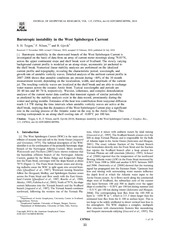Barotropic instability in the West Spitsbergen Current
Peer reviewed, Journal article
Published version

View/
Date
2010-07-24Metadata
Show full item recordCollections
- Geophysical Institute [1198]
Original version
Journal of Geophysical Research – Oceans 115: C07016 https://doi.org/10.1029/2009jc005996Abstract
Barotropic instability in the shoreward branch of the West Spitsbergen Current is investigated on the basis of data from an array of current meter moorings along 78.83°N, across the upper continental slope and shelf break west of Svalbard. The slowly varying background current profile is modeled as an along‐slope, asymmetric jet anchored to the shelf break. Numerical linear stability analyses are performed on the idealized current profile and topography, revealing the characteristic period, wavelength, and growth rate of unstable vorticity waves. Detailed analysis of the ambient current profile in 2007–2008 shows that unstable conditions are present during ∼40% of the 10 month measurement record, depending on the localization, width, and amplitude of the current jet. The resulting vorticity waves are localized at the shelf break and are able to exchange water masses across the oceanic Arctic front. Typical wavelengths and periods are 20–40 km and 40–70 h, respectively. Wavelet, coherence, and complex demodulation analyses of the current meter data confirm that transient signals of similar periodicity as predicted by the stability analysis exist in the data record, prominently during the winter and spring months. Estimates of the heat loss contribution from isopycnal diffusion reach 1.4 TW during the time intervals when unstable vorticity waves are active at the shelf break, implying that the dynamics of the West Spitsbergen Current play a significant role in the cooling process of the Atlantic water on the way to the Arctic Ocean. This cooling corresponds to an along‐shelf cooling rate of −0.08°C per 100 km.